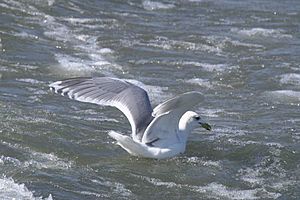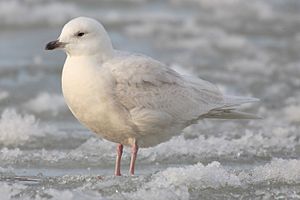Kumlien's gull facts for kids
Quick facts for kids Kumlien's gull |
|
|---|---|
 |
|
| Scientific classification |
|
| Kingdom: | Animalia |
| Phylum: | Chordata |
| Class: | Aves |
| Order: | Charadriiformes |
| Family: | Laridae |
| Genus: | Larus |
| Species: | |
| Subspecies: |
L. g. kumlieni
|
| Trinomial name | |
| Larus glaucoides kumlieni Brewster, 1883
|
|
The Kumlien's gull (Larus glaucoides kumlieni) is a type of Iceland gull. It is a large gull that lives in the Arctic parts of Canada. These birds migrate south for winter. They fly from Labrador down to New England and west across the Great Lakes.
This gull is named after a scientist called Ludwig Kumlien. Sometimes, a few Kumlien's gulls even visit Britain and Ireland.
About the Kumlien's Gull
For a long time, scientists debated if the Kumlien's gull was its own species. They also wondered if it was a type of Thayer's gull or a mix of different gulls. But since 2017, most scientists agree it is a subspecies of the Iceland gull.
Discovery and Life Cycle
The Kumlien's gull was first described in 1883 by William Brewster. He studied a bird found by Ludwig Kumlien during an Arctic trip.
These gulls build their nests on coasts and cliffs. They can nest in groups or alone. Their nests are made from grass, moss, or seaweed. Female gulls usually lay two or three light brown eggs.
Appearance and Sounds
Kumlien's gulls are generally pale in color. Their wingtips can look very different from one bird to another. Some have completely white wings, just like other Iceland gulls. Others have darker wings, looking more like Thayer's gulls. Even their eye color can change, from light yellow to dark brown. This wide range of looks makes some people think they might be a mix of different gull types.
Kumlien's gulls are usually smaller than the very large glaucous gull. They are also often smaller than the herring gull. It takes about four to five years for a young Kumlien's gull to get its full adult feathers. Their call sounds like a "laughing" cry, similar to a herring gull's, but it is higher pitched.
What They Eat
Like most gulls, Kumlien's gulls eat many different things. They are omnivores, meaning they eat both plants and animals. They often look for food that others have left behind. They also hunt for small animals.
These birds find food while flying, picking it up from the water's surface. They also walk or swim to find food. Because they are good at scavenging, you might see them near garbage dumps, sewage outlets, or places where fish are cleaned.


